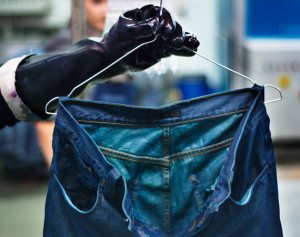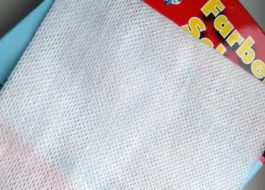Dyeing clothes in the washing machine
 Don't want to part with your favorite jeans or trousers, but they look faded? Then we suggest you paint them. This procedure scares many, but if you paint in an automatic machine, then there is nothing difficult. This article will describe in detail how to do this correctly, what paint to choose for clothes in the washing machine, and will it harm the equipment?
Don't want to part with your favorite jeans or trousers, but they look faded? Then we suggest you paint them. This procedure scares many, but if you paint in an automatic machine, then there is nothing difficult. This article will describe in detail how to do this correctly, what paint to choose for clothes in the washing machine, and will it harm the equipment?
The procedure for dyeing clothes in a washing machine
Before you dye your clothes in the washing machine, you need to wash them well. Only after this do we perform the following steps in sequence:
- Take fabric paint and dilute it according to the instructions. If the dye is liquid, then pour the required amount into a measuring container.
- Pour the paint into the powder tray.
- Place the wet clothes (jeans, coats or T-shirts) that you want to dye into the drum. Wet things stain better.
- Depending on the model of the washing machine, we select a washing mode in which the water in the drum is heated to a temperature of 90-950C. The washing time should be at least 30 minutes. More details about possible functions can be found in the article Functions and modes in the washing machine
Note! Longer washing will provide better dyeing of the fabric, its color will be more saturated.
- You can set an additional rinse to ensure that the excess dye is thoroughly rinsed out of the clothes.
- We start the wash and wait.
- Now we select the washing mode in cold water and wash the dyed clothes with powder. Cold water will set the dye into the fabric. You can rinse the item by hand, but be sure to use cold water.
- At the end of the procedure, the washing machine must be cleaned of paint. To do this, start the washing process with the addition of one glass of bleach. You can put old and unnecessary things. If there are none, then you need to start the car in idle mode. This procedure is done so that the remaining dye particles are washed out of the machine and do not spoil the items during the next wash.
So, the item is painted, all that remains is to dry it, and you can put it on again.
Does paint harm the washing machine?
 Having heard that clothes can be dyed in a washing machine, some may wonder what will happen to the machine after such a procedure. The question is quite reasonable, let's try to answer it. After the usual procedure of dyeing clothes with fabric dye, nothing will happen to the machine, since dyes do not contain aggressive chemicals. It is much more dangerous to pour vinegar or other acids into the car, which can lead to the destruction of rubber parts.
Having heard that clothes can be dyed in a washing machine, some may wonder what will happen to the machine after such a procedure. The question is quite reasonable, let's try to answer it. After the usual procedure of dyeing clothes with fabric dye, nothing will happen to the machine, since dyes do not contain aggressive chemicals. It is much more dangerous to pour vinegar or other acids into the car, which can lead to the destruction of rubber parts.
But it's not that simple. After such a procedure, paint particles may remain in the machine, which will require additional cleaning and rinsing. If you neglect this, then after the next wash you can remove stained items from the machine. That’s why it’s worth washing something you don’t need in it at least once.
Dyeing jeans and fabrics in a machine has a big advantage. You don’t have to constantly stir and turn the product with your hands when working with paint and boiling water. All this work is done by the technique, thereby ensuring uniform coloring. However, the final decision is up to you on how to dye your jeans in a washing machine or in a basin.
Dye for dyeing clothes
In order to dye clothes at home, you need to choose a suitable paint.The most important thing to consider is the type of fabric. If you are not sure what fabric the clothes are made of, then purchase universal dye. Let's look at the most common dyes.
- Surf dye – a universal dye, suitable for natural and artificial fabrics such as cotton, wool, nylon. The palette of this dye includes 10 colors. One packet of paint is designed to dye 0.5 kg of fabric.
- Simplicol brand paint – a paint intended for dyeing natural fabrics, as well as clothes consisting half of synthetics. Manufacturers of the dye warn that it is not suitable for dyeing wool, silk, cashmere, polyamide and polyurethane-coated clothing. There is a special dye marked for silk and wool. Note that this paint, unlike the previous one, contains a dye fixative. It is suitable for dyeing in the washing machine.
- Paint under the brand Fashion Color – fabric paint made in Germany, suitable for dyeing items in the washing machine. One package of paint is enough for 1.5 kg of clothes.
Important! The paint color declared by the manufacturer will be original only when dyeing white clothes; in other cases the tone will be different.
Alternative dyeing methods
If you still haven’t decided to dye it in the washing machine, you can try dyeing the product manually using one of the following methods.
The first method is to dye fabrics with natural dyes. Natural plants are used as such dyes. For example:
- Orange color is given by: carrots, plantain seeds, onion peels.
- Brown color is obtained from oak bark shavings, coffee, tea, nut shells, and dandelions.
- Berries give pink color: victoria, cherries, raspberries.
- Blue dye is found in cauliflower leaves, cornflower petals, blueberries, irises, and dark grapes.
- Red with a brownish tint will be obtained when stained with pomegranate juice, elderberry, beets, and hibiscus.
- The black color comes from ink nuts and blackberries.
- Green color is characteristic of sorrel roots, spinach leaves, lilac flowers, and yarrow.
- Yellow is obtained from bay leaves, calendula flowers, dandelions, St. John's wort, narcissus or turmeric.
Before you paint an item, you need to treat it with a fixative, which will help the paint adhere to the fabric. If the dye is berry, then use a salt solution as a fixative; take 125 grams of salt per 2 liters of water. If the dye is vegetable, then a solution of vinegar diluted in a ratio of 1:4 is used as a fixative, where 4 parts are water.
When the plant material is collected (leaves and berries must be ripe), it is cut into small pieces and placed in a large container. In this container you will dye clothes. Pour the dye with water and bring to a boil, then simmer the solution over low heat for about an hour.
Please pay attention! You need 2 times more water than dye.
After boiling, filter the water from the leaves or berries and place the product in it. We boil the clothes for an hour, turning them over periodically. The longer the item is in the water with the paint, the more intense the color will be. After the procedure, it is necessary to rinse the product well in cold water and air dry.
The second method involves the use of chemical dyes. To do this, pour water into a large container and boil. Next, add the fixing solution to the water.For cotton products, use salt at the rate of 1 cup per 3 liters of water, for synthetics, white vinegar, 1 cup per 3 liters of water.
Now add the dye, stir the water until it is completely dissolved. Next, put the clothes in the container, and, stirring for half an hour, simmer over low heat. All that remains is to rinse the product in plenty of water. You can rinse with hot water first, and then gradually reduce the water temperature. Rinsing in ice water will set the dye to the fabric.
Some tips for coloring
In conclusion, we offer some useful tips that will help you avoid common mistakes when dyeing clothes at home.
- Berry and vegetable dyes dye silk, wool and cotton better.
- It is not recommended to dye clothes made of polyester, acrylic, elastane, as well as clothes that are washed in cold water or only cleaned.
- Before the procedure, prepare napkins in case you accidentally spill paint. Wear gloves and an old robe.
- Strictly follow the instructions included with the dye.
- When dissolving paint, do not inhale it. Be sure to ventilate the room during and after work.
Good luck with your experiments with dyeing textiles in the washing machine!
Interesting:
3 reader comments
Add a comment Cancel reply
Categories
Washing machine repair


For buyers

For users

Dishwasher

















Thank you! Great tips!
Thank you
Thank you, I find the article very useful!
However, I also think that “universal fabric dye” is a very controversial definition!
Therefore, before dyeing, it is necessary to study the material, regarding what classes of dyes exist and for what textile materials they can be used; the relevant literature and resources can be easily found on the Internet.